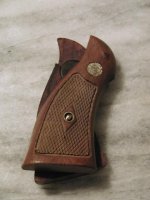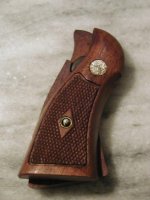That describes the grips that I put in my earlier posting. They looked absolutely dull and were late 50's vintage. When it comes to attempting to revive a finish, I'm a minimalist and feel people are far too eager to just break out the stripper and have at it, especially on the older grips, when it may not be needed.
You're most likely dealing with a boiled linseed oil type varnish, and Tru-oil which is a modified linseed oil, will have no problem being applied on top of it, if needed.
If they've been lightly used and finish looks intact, my first move with vintage grips is to see if a sheen can be raised on a small spot using a white cotton tee-shirt to buff it out, if you see that it can be done, then all the grips need is some elbow grease and hand polishing. For the checkered area, I use a new medium bristle toothbrush to buff them out the same way a brush is used to buff out/polish a shoe.
If a sheen can't be raised, then I use some thinned out Tru-oil (a 50/50 mix of thinner and oil) and apply a thin coat to the un-checkered sections, working the oil into the wood with my finger, I let it throughly dry and buff with the cotton T. For the checkered area, I use a soft toothbrush lightly dampened with some of the thinned out Tru-oil and apply sparingly to just wet the checkering, let it dry and use a clean tooth brush to burnish/buff it out.
The pictures of the grips in my other post where the "before' was dull and lifeless, all that I did to bring them back was buff them out and apply a coat of Renaissance Wax.


